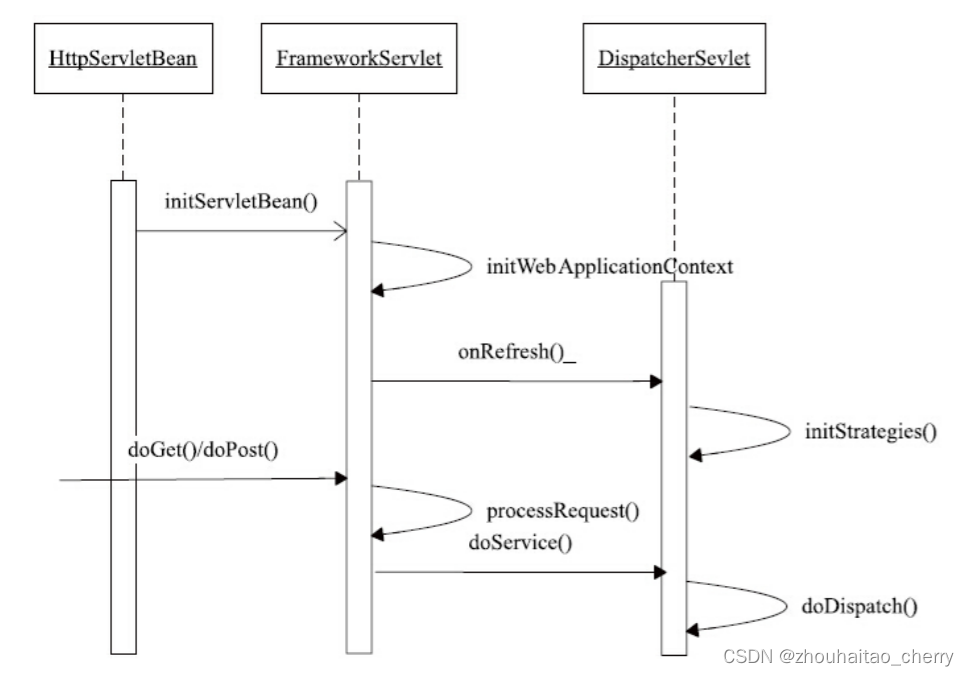Spring技术内幕笔记之SpringMvc
WebApplicationContext接口的类继承关系

org.springframework.web.context.ContextLoader#initWebApplicationContext 对IOC容器的初始化
SpringMvc如何设计
DispatcherServlet类继承关系

MVC处理流程图如下:

DispatcherServlet的工作大致可以分为两个部分:
-
初始化部分,由initServletBean()启动,通过initWebApplicationContext()方法最终调用DispatcherServlet的initStrategies方法,在这个方法里,DispatcherServlet对MVC模块的其他部分进行了初始化,比如handlerMapping、ViewResolver等;
-
对HTTP请求进行响应,作为一个Servlet,Web容器会调用Servlet的doGet()和doPost()方法,在经过FrameworkServlet的processRequest()简单处理后,会调用DispatcherServlet的doService()方法,在这个方法调用中封装了doDispatch(),这个doDispatch()是Dispatcher实现MVC模式的主要部分,会在下面进行详细的分析。
DispatcherServlet 启动与初始化
- Servlet初始化时org.apache.catalina.core.StandardWrapper#allocate,判断StandardWrapper实例是否存在(instanceInitialized状态标识),不存在则调用org.apache.catalina.core.StandardWrapper#initServlet方法进行初始化,然后调用javax.servlet.GenericServlet#init(javax.servlet.ServletConfig)方法,最终调用org.springframework.web.servlet.HttpServletBean#init方法
- init方法则调用org.springframework.web.servlet.HttpServletBean#init
public final void init() throws ServletException { // Set bean properties from init parameters. PropertyValues pvs = new ServletConfigPropertyValues(getServletConfig(), this.requiredProperties); if (!pvs.isEmpty()) { try { BeanWrapper bw = PropertyAccessorFactory.forBeanPropertyAccess(this); ResourceLoader resourceLoader = new ServletContextResourceLoader(getServletContext()); bw.registerCustomEditor(Resource.class, new ResourceEditor(resourceLoader, getEnvironment())); initBeanWrapper(bw); bw.setPropertyValues(pvs, true); } catch (BeansException ex) { if (logger.isErrorEnabled()) { logger.error("Failed to set bean properties on servlet '" + getServletName() + "'", ex); } throw ex; } } // Let subclasses do whatever initialization they like. initServletBean(); } - 可以看到最终会调用initServletBean方法,初始化实现是在org.springframework.web.servlet.FrameworkServlet#initServletBean
protected final void initServletBean() throws ServletException { getServletContext().log("Initializing Spring " + getClass().getSimpleName() + " '" + getServletName() + "'"); if (logger.isInfoEnabled()) { logger.info("Initializing Servlet '" + getServletName() + "'"); } long startTime = System.currentTimeMillis(); try { this.webApplicationContext = initWebApplicationContext(); initFrameworkServlet(); } catch (ServletException | RuntimeException ex) { logger.error("Context initialization failed", ex); throw ex; } if (logger.isDebugEnabled()) { String value = this.enableLoggingRequestDetails ? "shown which may lead to unsafe logging of potentially sensitive data" : "masked to prevent unsafe logging of potentially sensitive data"; logger.debug("enableLoggingRequestDetails='" + this.enableLoggingRequestDetails + "': request parameters and headers will be " + value); } if (logger.isInfoEnabled()) { logger.info("Completed initialization in " + (System.currentTimeMillis() - startTime) + " ms"); } } - 初始化Web容器是在initWebApplicationContext方法中,主要实现在org.springframework.web.servlet.FrameworkServlet#initWebApplicationContext
protected WebApplicationContext initWebApplicationContext() { WebApplicationContext rootContext = WebApplicationContextUtils.getWebApplicationContext(getServletContext()); WebApplicationContext wac = null; if (this.webApplicationContext != null) { // A context instance was injected at construction time -> use it wac = this.webApplicationContext; if (wac instanceof ConfigurableWebApplicationContext) { ConfigurableWebApplicationContext cwac = (ConfigurableWebApplicationContext) wac; if (!cwac.isActive()) { // The context has not yet been refreshed -> provide services such as // setting the parent context, setting the application context id, etc if (cwac.getParent() == null) { // The context instance was injected without an explicit parent -> set // the root application context (if any; may be null) as the parent cwac.setParent(rootContext); } configureAndRefreshWebApplicationContext(cwac); } } } if (wac == null) { // No context instance was injected at construction time -> see if one // has been registered in the servlet context. If one exists, it is assumed // that the parent context (if any) has already been set and that the // user has performed any initialization such as setting the context id wac = findWebApplicationContext(); } if (wac == null) { // No context instance is defined for this servlet -> create a local one wac = createWebApplicationContext(rootContext); } if (!this.refreshEventReceived) { // Either the context is not a ConfigurableApplicationContext with refresh // support or the context injected at construction time had already been // refreshed -> trigger initial onRefresh manually here. synchronized (this.onRefreshMonitor) { onRefresh(wac); } } if (this.publishContext) { // Publish the context as a servlet context attribute. String attrName = getServletContextAttributeName(); getServletContext().setAttribute(attrName, wac); } return wac; } - 可看到创建Web容器是在createWebApplicationContext方法中,主要实现在org.springframework.web.servlet.FrameworkServlet#createWebApplicationContext(org.springframework.context.ApplicationContext)
protected WebApplicationContext createWebApplicationContext(@Nullable ApplicationContext parent) { Class<?> contextClass = getContextClass(); if (!ConfigurableWebApplicationContext.class.isAssignableFrom(contextClass)) { throw new ApplicationContextException( "Fatal initialization error in servlet with name '" + getServletName() + "': custom WebApplicationContext class [" + contextClass.getName() + "] is not of type ConfigurableWebApplicationContext"); } ConfigurableWebApplicationContext wac = (ConfigurableWebApplicationContext) BeanUtils.instantiateClass(contextClass); wac.setEnvironment(getEnvironment()); wac.setParent(parent); String configLocation = getContextConfigLocation(); if (configLocation != null) { wac.setConfigLocation(configLocation); } configureAndRefreshWebApplicationContext(wac); return wac; } - 此时就创建成功了Web容器 ConfigurableWebApplicationContext,然后调用配置启动并初始化容器,调用configureAndRefreshWebApplicationContext方法,代码如下:
protected void configureAndRefreshWebApplicationContext(ConfigurableWebApplicationContext wac) { if (ObjectUtils.identityToString(wac).equals(wac.getId())) { // The application context id is still set to its original default value // -> assign a more useful id based on available information if (this.contextId != null) { wac.setId(this.contextId); } else { // Generate default id... wac.setId(ConfigurableWebApplicationContext.APPLICATION_CONTEXT_ID_PREFIX + ObjectUtils.getDisplayString(getServletContext().getContextPath()) + '/' + getServletName()); } } wac.setServletContext(getServletContext()); wac.setServletConfig(getServletConfig()); wac.setNamespace(getNamespace()); wac.addApplicationListener(new SourceFilteringListener(wac, new ContextRefreshListener())); // The wac environment's #initPropertySources will be called in any case when the context // is refreshed; do it eagerly here to ensure servlet property sources are in place for // use in any post-processing or initialization that occurs below prior to #refresh ConfigurableEnvironment env = wac.getEnvironment(); if (env instanceof ConfigurableWebEnvironment) { ((ConfigurableWebEnvironment) env).initPropertySources(getServletContext(), getServletConfig()); } postProcessWebApplicationContext(wac); applyInitializers(wac); wac.refresh(); } - 可以看到最终调用了org.springframework.context.support.AbstractApplicationContext#refresh方法初始化容器。
可看到创建Web容器时,设置了父容器,DispatcherServlet持有一个以自己的Servlet名称命名的IOC容器。
SpringMvc 路径与HandlerMethod初始化
org.springframework.web.servlet.mvc.method.annotation.RequestMappingHandlerMapping的子类实现了InitializingBean接口,就必须实现afterPropertiesSet方法,主要实现如下:
public void afterPropertiesSet() {
this.config = new RequestMappingInfo.BuilderConfiguration();
this.config.setTrailingSlashMatch(useTrailingSlashMatch());
this.config.setContentNegotiationManager(getContentNegotiationManager());
if (getPatternParser() != null) {
this.config.setPatternParser(getPatternParser());
Assert.isTrue(!this.useSuffixPatternMatch && !this.useRegisteredSuffixPatternMatch,
"Suffix pattern matching not supported with PathPatternParser.");
}
else {
this.config.setSuffixPatternMatch(useSuffixPatternMatch());
this.config.setRegisteredSuffixPatternMatch(useRegisteredSuffixPatternMatch());
this.config.setPathMatcher(getPathMatcher());
}
super.afterPropertiesSet();
}
可看到除了针对config做了一些初始设置操作外,最终调用了父类的afterPropertiesSet()实现,如下:
@Override
public void afterPropertiesSet() {
initHandlerMethods();
}
最终调用org.springframework.web.servlet.handler.AbstractHandlerMethodMapping#initHandlerMethods方法,如下:
protected void initHandlerMethods() {
for (String beanName : getCandidateBeanNames()) {
if (!beanName.startsWith(SCOPED_TARGET_NAME_PREFIX)) {
processCandidateBean(beanName);
}
}
handlerMethodsInitialized(getHandlerMethods());
}
可看到关键方法org.springframework.web.servlet.handler.AbstractHandlerMethodMapping#processCandidateBean
protected void processCandidateBean(String beanName) {
Class<?> beanType = null;
try {
beanType = obtainApplicationContext().getType(beanName);
}
catch (Throwable ex) {
// An unresolvable bean type, probably from a lazy bean - let's ignore it.
if (logger.isTraceEnabled()) {
logger.trace("Could not resolve type for bean '" + beanName + "'", ex);
}
}
if (beanType != null && isHandler(beanType)) {
detectHandlerMethods(beanName);
}
}
此处调用了isHandler方法进行过滤,排除没有Controller或者RequestMapping注解Bean,实现如下:
@Override
protected boolean isHandler(Class<?> beanType) {
return (AnnotatedElementUtils.hasAnnotation(beanType, Controller.class) ||
AnnotatedElementUtils.hasAnnotation(beanType, RequestMapping.class));
}
然后调用org.springframework.web.servlet.handler.AbstractHandlerMethodMapping#detectHandlerMethods方法,代码如下:
protected void detectHandlerMethods(Object handler) {
Class<?> handlerType = (handler instanceof String ?
obtainApplicationContext().getType((String) handler) : handler.getClass());
if (handlerType != null) {
Class<?> userType = ClassUtils.getUserClass(handlerType);
Map<Method, T> methods = MethodIntrospector.selectMethods(userType,
(MethodIntrospector.MetadataLookup<T>) method -> {
try {
return getMappingForMethod(method, userType);
}
catch (Throwable ex) {
throw new IllegalStateException("Invalid mapping on handler class [" +
userType.getName() + "]: " + method, ex);
}
});
if (logger.isTraceEnabled()) {
logger.trace(formatMappings(userType, methods));
}
else if (mappingsLogger.isDebugEnabled()) {
mappingsLogger.debug(formatMappings(userType, methods));
}
methods.forEach((method, mapping) -> {
Method invocableMethod = AopUtils.selectInvocableMethod(method, userType);
registerHandlerMethod(handler, invocableMethod, mapping);
});
}
}
此处关键方法,org.springframework.web.servlet.handler.AbstractHandlerMethodMapping#registerHandlerMethod,实现如下:
protected void registerHandlerMethod(Object handler, Method method, T mapping) {
this.mappingRegistry.register(mapping, handler, method);
}
进入org.springframework.web.servlet.handler.AbstractHandlerMethodMapping.MappingRegistry#register,进行注册,代码如下:
public void register(T mapping, Object handler, Method method) {
this.readWriteLock.writeLock().lock();
try {
HandlerMethod handlerMethod = createHandlerMethod(handler, method);
validateMethodMapping(handlerMethod, mapping);
Set<String> directPaths = AbstractHandlerMethodMapping.this.getDirectPaths(mapping);
for (String path : directPaths) {
this.pathLookup.add(path, mapping);
}
String name = null;
if (getNamingStrategy() != null) {
name = getNamingStrategy().getName(handlerMethod, mapping);
addMappingName(name, handlerMethod);
}
CorsConfiguration corsConfig = initCorsConfiguration(handler, method, mapping);
if (corsConfig != null) {
corsConfig.validateAllowCredentials();
this.corsLookup.put(handlerMethod, corsConfig);
}
this.registry.put(mapping,
new MappingRegistration<>(mapping, handlerMethod, directPaths, name, corsConfig != null));
}
finally {
this.readWriteLock.writeLock().unlock();
}
}
可看到registry将mapping添加成功,根据前面的rg.springframework.web.servlet.handler.AbstractHandlerMethodMapping#initHandlerMethods循环调用,会将所有的Controller里面的路径与MappingRegistration添加至Map<T, MappingRegistration> registry中。效果如下:

至此,Spring完成了所有的Controller的路径注册过程。
本文来自互联网用户投稿,该文观点仅代表作者本人,不代表本站立场。本站仅提供信息存储空间服务,不拥有所有权,不承担相关法律责任。 如若内容造成侵权/违法违规/事实不符,请联系我的编程经验分享网邮箱:veading@qq.com进行投诉反馈,一经查实,立即删除!